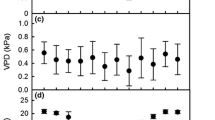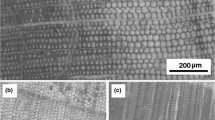Abstract
It is difficult to scale up measurements of the sap flux density (Js) for the characterization of tree or stand transpiration (E) due to spatial variations in JS and their temporal changes. To assess spatial variations in the sap flux density of Korean pine (Pinus koraiensis) and their effects on E estimates, we measured the Js using Granier-type sensors. Within trees, the Js decreased exponentially with the radial depth, and the Js of the east aspects were higher than those of the west aspects. Among trees, there was a positive relationship between Js and the tree diameter at breast height, and this positive relationship became stronger as the transpiration demand increased. The spatial variations that caused large errors in E estimates (i.e., up to 110.8 % when radial variation was ignored) had varied systematically with environmental factors systematic characteristics in relation to environmental factors. However, changes in these variations did not generate substantial errors in the E estimates. For our study periods, the differences in the daily E (E D) calculated by ignoring radial, azimuthal and tree-to-tree variations and the measured E D were fairly constant, especially when the daily vapor pressure deficit (D_D) was higher than 0.6 kPa. These results imply that the effect of spatial variations changes on sap flow can be a minor source of error compared with spatial variations (radial, azimuthal and tree-to-tree variations) when considering E estimates.
Similar content being viewed by others
References
Alvarado-Barrientos MS, Hernández-Santana V, Asbjornsen H (2013) Variability of the radial profile of sap velocity in Pinus patula from contrasting stands within the seasonal cloud forest zone of Veracruz, Mexico. Agricultural and Forest Meteorology 168: 108–119. DOI: 10.1016/j.agrformet.2012.08.004
Ares A, Fownes JH (1999) Water supply regulates structure, productivity, and water use efficiency of Acacia koa forest in Hawaii. Oecologia 121: 458–466. DOI: 10.1007/s004420050952
Barij N, Cermák J, Stokes A (2011) Azimuthal Variations in Xylem Structure and Water Relations in Cork Oak (Quercus Suber). Iawa Journal 32: 25–40. DOI: 10.1163/22941932-90000040
Caird MA, Richards JH, Donovan LA (2007) Nighttime stomatal conductance and transpiration in C3 and C4 plants. Plant Physiology 143: 4–10. DOI: 10.1104/pp.106.092940
Catoni R, Gratani L (2014) Variations in leaf respiration and photosynthesis ratio in response to air temperature and water availability among Mediterranean evergreen species. Journal of Arid Environments 102: 82–88. DOI: 10.1016/j.jaridenv.2013.11.013
Caylor KK, Dragoni D (2009) Decoupling structural and environmental determinants of sap velocity: Part I. Methodological development. Agricultural and Forest Meteorology 149: 559–569. DOI: 10.1016/j.agrformet.2008.10.006
Cermak J, Kucera J, Nadezhdina N (2004) Sap flow measurements with some thermodynamic methods, flow integration within trees and scaling up from sample trees to entire forest stands. Trees-Structure and Function 18: 529–546. DOI: 10.1007/s00468-004-0339-6
Chang X, Zhao W, He Z (2014) Radial pattern of sap flow and response to microclimate and soil moisture in Qinghai spruce (Picea crassifolia) in the upper Heihe River Basin of arid northwestern China. Agricultural and Forest Meteorology 187: 14–21. DOI: 10.1016/j.agrformet.2013.11.004
Clearwater MJ, Meinzer FC, Andrade JL, et al. (1999) Potential errors in measurement of nonuniform sap flow using heat dissipation probes. Tree Physiology 19: 681–687. DOI: 10.1093/treephys/19.10.681
Dawson TE, Burgess SS, Tu KP, et al. (2007) Nighttime transpiration in woody plants from contrasting ecosystems. Tree Physiology 27: 561–575. DOI: 10.1093/treephys/27.4.561
Delzon S, Sartore M, Granier A, et al. (2004) Radial profiles of sap flow with increasing tree size in maritime pine. Tree Physiology 24: 1285–1293. DOI: 10.1093/treephys/24.11.1285
Dragoni D, Caylor KK, Schmid HP (2009) Decoupling structural and environmental determinants of sap velocity. Agricultural and Forest Meteorology 149: 570–581. DOI: 10.1016/j.agrformet.2008.10.010
Ewers BE, Mackay DS, Tang J, et al. (2008) Intercomparison of sugar maple (Acer saccharum Marsh.) stand transpiration responses to environmental conditions from the Western Great Lakes Region of the United States. Agricultural and Forest Meteorology 148: 231–246. DOI: 10.1016/j.agrformet. 2007.08.003
Farquhar GD, Roderick ML (2003) Pinatubo, diffuse light, and the carbon cycle. Science 299: 1997–1998. DOI: 10.1126/science.1080681
Fiora A, Cescatti A (2006) Diurnal and seasonal variability in radial distribution of sap flux density: implications for estimating stand transpiration. Tree Physiology 26: 1217–1225. DOI: 10.1093/treephys/26.9.1217
Ford CR, McGuire MA, Mitchell RJ, et al. (2004) Assessing variation in the radial profile of sap flux density in Pinus species and its effect on daily water use. Tree Physiology 24: 241–249. DOI: 10.1093/treephys/24.3.241
Granier A (1985) Une nouvelle méthode pour la mesure du flux de sève brute dans le tronc des arbres. Annals of Forest Science 42: 193–200. (In French)
Granier A (1987) Evaluation of transpiration in a Douglas-fir stand by means of sap flow measurements. Tree Physiology 3: 309–320. DOI: 10.1093/treephys/3.4.309
Granier A, Biron P, Breda N, et al. (1996) Transpiration of trees and forest stands: short and long-term monitoring using sapflow methods. Global Change Biology 2: 265–274. DOI: 10.1111/j.1365-2486.1996.tb00078.x
Gu LH, Fuentes JD, Shugart HH, et al. (1999) Responses of net ecosystem exchanges of carbon dioxide to changes in cloudiness: Results from two North American deciduous forests. Journal of Geophysical Research-Atmospheres 104: 31421–31434. DOI: 10.1029/1999jd901068
Guo Q-q, Zhang W-h (2015) Sap flow of Abies georgei var. smithii and its relationship with the environment factors in the Tibetan subalpine region, China. Journal of Mountain Science 12: 1373–1382. DOI: 10.1007/s11629-015-3618-3
Hatton TJ, Moore SJ, Reece PH (1995) Estimating stand transpiration in a Eucalyptus populnea woodland with the heat pulse method: measurement errors and sampling strategies. Tree Physiology 15: 219–227. DOI: 10.1093/treephys/15.4.219
Jiménez MS, Nadezhdina N, Cermák J, et al. (2000) Radial variation in sap flow in five laurel forest tree species in Tenerife, Canary Islands. Tree Physiology 20: 1149–1156. DOI: 10.1093/treephys/20.17.1149
Jimenez E, Vega JA, Perez-Gorostiaga P, et al. (2010) Evaluation of sap flow density of Acacia melanoxylon R. Br. (blackwood) trees in overstocked stands in north-western Iberian Peninsula. European Journal of Forest Research 129: 61–72. DOI: 10.1007/s10342-008-0252-4
Köstner B, Granier A, Cermák J (1998) Sapflow measurements in forest stands: methods and uncertainties. Annals of forest science 55: 13–27. DOI: 10.1051/forest:19980102
Kim HS, Oren R, Hinckley TM (2008) Actual and potential transpiration and carbon assimilation in an irrigated poplar plantation. Tree Physiology 28: 559–577. DOI: 10.1093/treephys/28.4.559
Kim HS, Palmroth S, Therezien M, et al. (2011) Analysis of the sensitivity of absorbed light and incident light profile to various canopy architecture and stand conditions. Tree Physiology 31: 30–47. DOI: 10.1093/treephys/tpq098
Kubota M, Tenhunen J, Zimmermann R, et al. (2005) Influences of environmental factors on the radial profile of sap flux density in Fagus crenata growing at different elevations in the Naeba Mountains, Japan. Tree Physiology 25: 545–556. DOI: 10.1093/treephys/25.5.545
Kumagai T, Aoki S, Nagasawa H, et al. (2005) Effects of tree-totree and radial variations on sap flow estimates of transpiration in Japanese cedar. Agricultural and Forest Meteorology 135: 110–116. DOI: 10.1016/j.agrformet.2005.11.007
Kume T, Tsuruta K, Komatsu H, et al. (2010) Effects of sample size on sap flux-based stand-scale transpiration estimates. Tree Physiology 30: 129–138. DOI: 10.1093/treephys/tpp074
Lüttschwager D, Remus R (2007) Radial distribution of sap flux density in trunks of a mature beech stand. Annals of forest science 64: 431–438. DOI: 10.1051/forest:2007020
Lagergren F, Lindroth A (2004) Variation in sapflow and stem growth in relation to tree size, competition and thinning in a mixed forest of pine and spruce in Sweden. Forest Ecology and Management 188: 51–63. DOI: 10.1016/j.foreco.2003.07.018
Lu P, Muller WJ, Chacko EK (2000) Spatial variations in xylem sap flux density in the trunk of orchard-grown, mature mango trees under changing soil water conditions. Tree Physiology 20: 683–692. DOI: 10.1093/treephys/20.10.683
Martin TA, Brown KJ, Cermák J, et al. (1997) Crown conductance and tree and stand transpiration in a secondgrowth Abies amabilis forest. Canadian Journal of Forest Research 27: 797–808. DOI: 10.1139/cjfr-27-6-797
Moon M, Kim T, Park J, et al. (2015) Variation in sap flux density and its effect on stand transpiration estimates of Korean pine stands. Journal of Forest Research 20: 85–93. DOI: 10.1007/s10310-014-0463-0
Nadezhdina N, Cermák J, Ceulemans R (2002) Radial patterns of sap flow in woody stems of dominant and understory species: scaling errors associated with positioning of sensors. Tree Physiology 22: 907–918. DOI: 10.1093/treephys/22.13.907
Oliveras I, Llorens P (2001) Medium-term sap flux monitoring in a Scots pine stand: analysis of the operability of the heat dissipation method for hydrological purposes. Tree Physiology 21: 473–480. DOI: 10.1093/treephys/21.7.473
Oren R, Pataki DE (2001) Transpiration in response to variation in microclimate and soil moisture in southeastern deciduous forests. Oecologia 127: 549–559. DOI: 10.1007/s004420000622
Oren R, Phillips N, Ewers B, et al. (1999) Sap-flux-scaled transpiration responses to light, vapor pressure deficit, and leaf area reduction in a flooded Taxodium distichum forest. Tree Physiology 19: 337–347. DOI: 10.1093/treephys/19.6.337
Oren R, Phillips N, Katul G, et al. (1998) Scaling xylem sap flux and soil water balance and calculating variance: a method for partitioning water flux in forests. Annals of forest science 55: 191–216. DOI: 10.1051/forest:19980112
Paudel I, Kanety T, Cohen S (2013) Inactive xylem can explain differences in calibration factors for thermal dissipation probe sap flow measurements. Tree Physiology 33: 986–1001. DOI: 10.1093/treephys/tpt070
Pausch RC, Grote EE, Dawson TE (2000) Estimating water use by sugar maple trees: considerations when using heat-pulse methods in trees with deep functional sapwood. Tree Physiology 20: 217–227. DOI: 10.1093/treephys/20.4.217
Poyatos R, Cermák J, Llorens P (2007) Variation in the radial patterns of sap flux density in pubescent oak (Quercus pubescens) and its implications for tree and stand transpiration measurements. Tree Physiology 27: 537–548. DOI: 10.1093/treephys/27.4.537
Ryu D, Moon M, Park J, et al. (2014) Development of Allometric Equations for V Age-class Pinus koraiensis in Mt. Taehwa Plantation, Gyeonggi-do. Korean Journal of Agricultural and Forest Meteorology 16: 29–38. DOI: 10.5532/KJAFM.2014.16.1.29. (In Korean)
Suh S, Park S, Shim K, et al. (2014) The effect of rain fall event on CO2 emission in Pinus koraiensis plantation in Mt. Taehwa. Korean Journal of Environmental Biology 32: 389–394. DOI: 10.11626/KJEB.2014.32.4.389. (In Korean)
Saveyn A, Steppe K, Lemeur R (2008) Spatial variability of xylem sap flow in mature beech (Fagus sylvatica) and its diurnal dynamics in relation to microclimate. Botany 86: 1440–1448. DOI: 10.1139/B08-112
Schäfer KV, Oren R, Ellsworth DS, et al. (2003) Exposure to an enriched CO2 atmosphere alters carbon assimilation and allocation in a pine forest ecosystem. Global Change Biology 9: 1378–1400. DOI: 10.1046/j.1365-2486.2003.00662.x
Shinohara Y, Tsuruta K, Ogura A, et al. (2013) Azimuthal and radial variations in sap flux density and effects on stand-scale transpiration estimates in a Japanese cedar forest. Tree Physiology 33: 550–558. DOI: 10.1093/treephys/tpt029
Sun HZ, Aubrey DP, Teskey RO (2012) A simple calibration improved the accuracy of the thermal dissipation technique for sap flow measurements in juvenile trees of six species. Trees-Structure and Function 26: 631–640. DOI: 10.1007/s00468-011-0631-1
Tsuruta K, Kume T, Komatsu H, et al. (2010) Azimuthal variations of sap flux density within Japanese cypress xylem trunks and their effects on tree transpiration estimates. Journal of Forest Research 15: 398–403. DOI: 10.1007/s10310-010-0202-0
Vandegehuchte MW, Steppe K (2013) Sap-flux density measurement methods: working principles and applicability. Functional Plant Biology 40: 213–223. DOI: 10.1071/FP12233_CO
Wilson KB, Hanson PJ, Mulholland PJ, et al. (2001) A comparison of methods for determining forest evapotranspiration and its components: sap-flow, soil water budget, eddy covariance and catchment water balance. Agricultural and Forest Meteorology 106: 153–168. DOI: 10.1016/S0168-1923(00)00199-4
Wullschleger SD, King AW (2000) Radial variation in sap velocity as a function of stem diameter and sapwood thickness in yellow-poplar trees. Tree Physiology 20: 511–518. DOI: 10.1093/treephys/20.8.511
Zhang JG, He QY, Shi WY, et al. (2015) Radial variations in xylem sap flow and their effect on whole-tree water use estimates. Hydrological Processes 29: 4993–5002. DOI: 10.1002/hyp.10465
Author information
Authors and Affiliations
Corresponding author
Additional information
http://orcid.org/0000-0003-0268-1834
http://orcid.org/0000-0002-9837-7812
http://orcid.org/0000-0001-7985-5404
http://orcid.org/0000-0002-1775-7945
http://orcid.org/0000-0002-0782-0859
http://orcid.org/0000-0003-3685-2371
http://orcid.org/0000-0002-3440-6071
Rights and permissions
About this article
Cite this article
Moon, M., Kim, T., Park, J. et al. Changes in spatial variations of sap flow in Korean pine trees due to environmental factors and their effects on estimates of stand transpiration. J. Mt. Sci. 13, 1024–1034 (2016). https://doi.org/10.1007/s11629-015-3793-2
Received:
Accepted:
Published:
Issue Date:
DOI: https://doi.org/10.1007/s11629-015-3793-2




